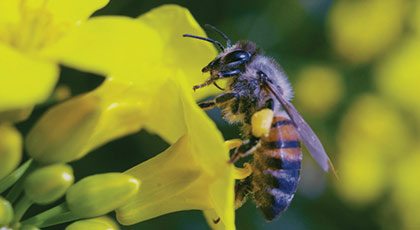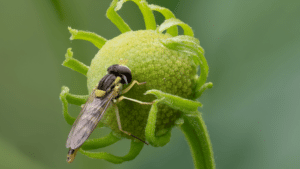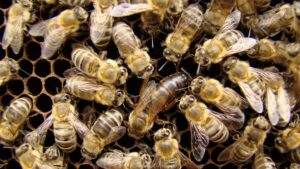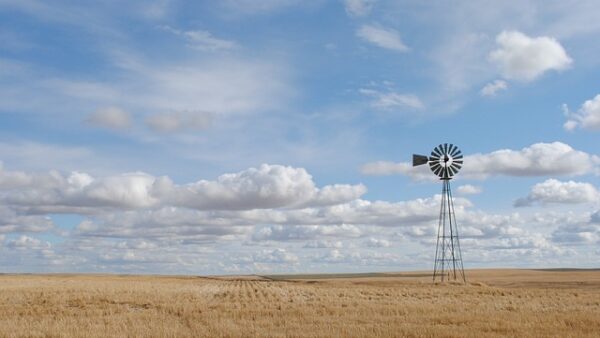Declining populations in pollinating species around the globe have caused pollinator health to become a much-debated topic in both public and scientific communities. And while all pollinators play a vital role in our ecosystem, Apis mellifera, the western honey bee, has taken top priority in many research labs across the country due to the critical pollination services it provides to North America’s agriculture industry.
Throughout North America, the honey bee is maintained as managed livestock and utilized to pollinate over one-third of the food we consume. At the same time, this tiny insect is combating a number of different stressors that have been and are actively culminating and ultimately affecting honey bee populations—and in turn threatening pollination services.
“Honey bee health is a very complicated situation. These bees and their colonies are highly complex organisms living in a variety of different landscapes with numerous detrimental factors affecting them. Complicating that further, these detrimental factors are both difficult for researchers to detect and monitor,” says Vicki Wojcik, research program manager for the Pollinator Partnership, the world’s largest organization devoted exclusively to pollinator conservation. “This issue is multi-layered and will require contributions from all different industry stakeholders in order to come to any valuable solutions.”
Research groups throughout the country echo that the issue of honey bee health is highly complicated, but many feel that the industry is heading in a positive direction in regards to research, product development, and stewardship measures.
“Currently, there is an abundance of stakeholders working to advance this field, and every day we are learning more and developing solutions to better the health landscape of these pollinators,” Wojcik continues.
Since the mid-2000s the U.S. Department of Agriculture, U.S. Environmental Protection Agency, as well as a number of public and private partners, have invested considerable resources to better address pollinator declines and the major factors that are adversely affecting bee health.
In October 2012, several of these industry partners came together for a National Stakeholders Conference on Honey Bee Health, and in May of 2013, the USDA released a report on the findings from this conference. This report identified the four major influences affecting the decline in pollinator health to be:
• nutrition;
• parasites and disease;
• genetics;
• and pesticide exposure.
Wojcik, who oversees the Pollinator Partnership’s research grants, funding and programs, says that many of the industry and non-industry research initiatives currently underway reflect similar priorities as stated in the USDA’s report on the National Stakeholders Conference on Honey Bee Health.
“Many of the research priorities right now are focused on nutrition, parasites and disease, genetics, and crop protection product impacts. In particular, we are seeing much of the focus [concentrating on] the varroa mite, determining the nutritional value different crops provide honey bees, as well as several studies on the interaction honeybees are having with pesticides,” continues Wojcik.
Varroa mites are a major threat to honey bee health and are becoming resistant to two compounds being used to control them.
Nutrition
Research and scientific data on the nutritional requirements of honey bees and the nutritional value that crops provide the honey bee is in the infancy stage. However, there are certainly a number of research groups across the country dedicated to examining these different nutritional factors of the honeybee—including studies looking at what a bee needs in order to have optimal health, as well as the reality of what is available to the bees as they move across the pollination landscape in the United States.
“A lot of the current initiatives we see are trying to address what type of floral landscape composition you need for a balanced diet in the honey bee,” explains Wojcik. “Researchers are trying to understand what nutrition the bees are receiving from which food, and then what food is actually, realistically available to them throughout the year.”
Wojcik notes that a possible contributing factor to declining honey bee health is that in commercial beekeeping, bees are moved into large single-forage areas where they are required to pollinate a single crop during its time of bloom. Once the pollination season is over for that certain crop, the bees are left in these single-forage locations, a lot of times with no other source of nutrition.
“The nutritional aspect of honey bee forage is extremely important because of the dynamic about how this species is managed. Almost all managed livestock in the United States are fed structured and balanced diets, but honey bees are presented with a succession of single food sources as the move from pollination contract to contract–and not every crop they pollinate is providing the correct balanced nutrition they need. Current research initiatives are trying to determine what to do, nutritionally speaking, with a bee that is moved from place-to-place to pollinate different crops, [and] how to manage the complex nutrition of a system where you have single-food sources that occur in tight time frames.”
Iain Kelly, bee health issues manager with Bayer Bee Care Centre, agrees that a more detailed understanding of the nutritional value crops and artificial diets provide the honey bee would be beneficial and would certainly aid beekeepers when they are required to supplement the bees’ diet during transportation and staging prior to pollination services. Kelly also notes one of the major concerns he is seeing, in regards to nutrition, is the need to develop more accessible forage in agriculture areas where bees are placed to pollinate and rest between pollination contracts.
“Much of the conservation land that provided good forage. in certain areas of the United States has been lost. There have been millions of acres that have come out of conservation programs over the past few years, which has been extremely detrimental to bees and beekeepers,” explains Kelly. “The National Resource Conservation Service has several projects going on in attempts to encourage the planting of more bee-nutritious forage and help combat the deteriorating conservation land.”
Honey bee nutrition is an area of honey bee health that has a number of unanswered questions. Moving forward, the research community is working on a variety of different initiatives devoted to better understanding what bees need, the nutritional value of different crops, as well as establishing nutrient-rich, diverse forage in pollination areas throughout the country.
“In recent years, the multiple stakeholders involved in this issue have begun to communicate and work together better, and we have had a lot of discussion,” says Kelly. “We are now seeing a more focused approach to where solutions are needed. Hopefully these efforts will come to fruition over the next few years and provide practical solutions for the benefit of the bees and beekeepers.”
Scientists and regulatory authorities agree that bee health is a complex issue. Several studies have also indicated that bee health may be affected by many different factors, including pests and parasites, microbial diseases, inadequate diet, bee management practices and climate change.
Parasites and Disease
Throughout the United States, there are several different parasites and diseases impacting colony numbers, but it has been clearly indicated in numerous scientific studies that the most detrimental factor affecting honey bee health is the Varroa destructor, more commonly known as the Varroa mite.
Both the varroa mite along with the disease Nosema spp. have been held responsible for significant depopulation and slow growth of honey bee colonies. The Varroa mite was found to be associated with more than 85 percent of the mortality cases in a study conducted last year by a research team at the University of Guelph in Guelph, Ontario, Canada. The study also suggests that many bee colonies are dying as a consequence of combined effects of the parasites Varroa destructor and Nosema spp.
“Current methods used to control these parasites rely upon the application of synthetic medicaments (miticides and antibiotics). However, the continuous use of these products has led to the development of mite resistance to the active ingredients and the same could happen with the antibiotic used to control Nosema disease,” explains Ernesto Guzman, professor at the school of environmental sciences with the University of Guelph. “Additionally, the use of synthetic chemicals implies a risk of contamination with toxic residues to honey and other hive products.” Guzman notes that new strategies of mite control are needed.
Nosema disease is caused by the fungus Nosema apis and has existed for many years, but scientists warn that the disease could have become more damaging to bee colonies due to the recent finding in North America of Nosema ceranae, a new Nosema species, whose original host is the Asiatic bee, Apis cerana.
“The presence of Nosema ceranae was confirmed in 2007. This new species of nosema has been associated [with] the collapse of thousands of colonies in Europe, and thus is a very likely suspect of colony losses and poor colony development in North America as well,” explains Guzman.
“Scientists are working to alter the bee’s genetic aspects similar to the way cattle are bred to produce more milk.”
|
Wojcik agrees with the University of Guelph’s study, stating “researchers and beekeepers are dealing with the challenge that the Varroa mites and nosema have developed resistance to many of the modes of action that are currently on the market.” She adds that “There are numerous studies being undertaken to aid this issue, from the development of new miticides to extensive genetic research.”
Wojcik explains genetic research that is working to selectively breed bees that have particular genetic behavior that will help rid them of varroa mites. “There are studies underway that will help bees either remove larvae and individual bees that are infected with Varroa, or genetically alter them to clean themselves more frequently. Scientists are also working to breed bees with selected genetic traits that are more hygenic, similar to the way cattle are bred to produce more milk,” says Wojcik.
Several research strategies are being conducted to better understand the nature of parasitic effects, as well as to develop new control methods for Varroa destructor and Nosema spp. Moving forward, researchers are confident that they are making positive progress toward initial steps that will ultimately aid honey bee health.
“The research community is moving in a good direction. There are so many different stakeholders invested in finding solutions to many of the problems that honey bees are facing, and these researchers are quite responsive to the industry and issues that arise,” says Wojcik. “Everyday advancements are being made and technologies and application processes are improving. Looking at the overall landscape of research and development in honey bee health, we are moving in a very positive direction.”
In the next Seed World…
Watch for Part V of Seed World’s Protecting Pollinators series, which will continue to examine the current industry and non-industry initiatives geared to aiding honey bee health, in particular, initiatives focused on the relationship between crop protection products and honey bees as well as developments in honey bee breeding.
Visit the links below to read more of Seed World‘s Protecting Pollinators series:




















